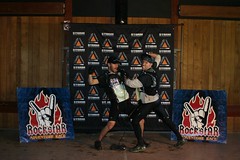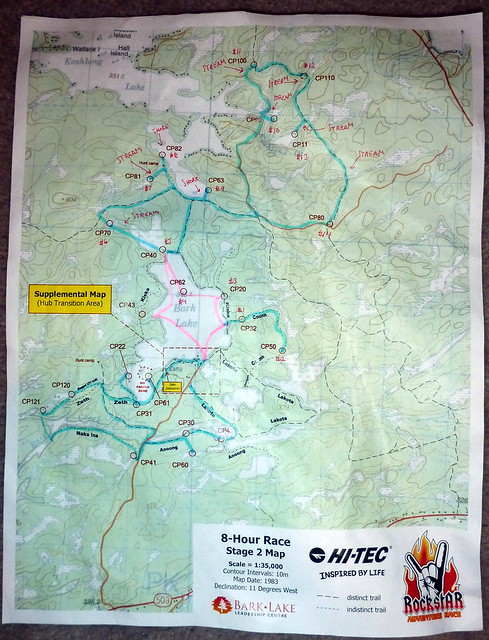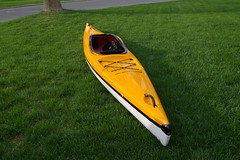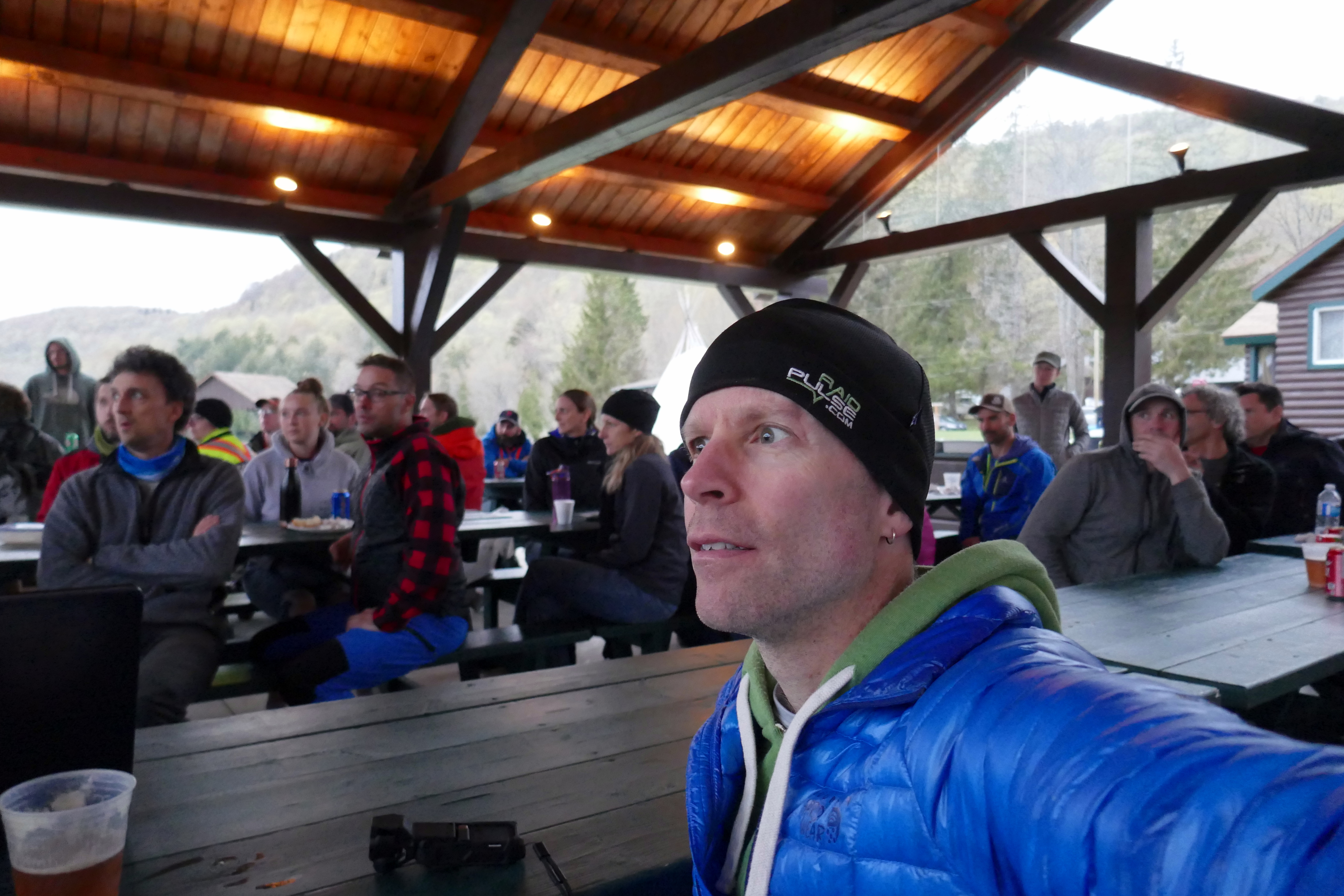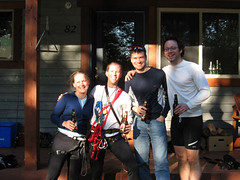Greetings friends, and welcome to another exciting race report from the wilds of the Muskoka region! Yup, that’s right, once again, I made my way into the beautiful lands west of Ottawa and north of Toronto. This time, I was taking part in the RockstAR Adventure Race, an 8-hour rogaine-style adventure race (more on this later), with my friend and team-mate of years gone by, Carl. And for a change, I actually wasn’t covering this event for the magazine. I was bona-fide just there for some fun and a good hard race with no thought being given to capturing good footage to distil the entire event into a little video. Of course, that doesn’t mean that I didn’t have a camera with me, and to those ends, why not check out some of the pictures I took before reading the rest of the post? It was another fun-filled weekend, with great weather, and a pretty cool race experience. Find out all about it after the jump!
Race Pictures
My decision to try this race out came pretty early in the season. I actually had it on my list of events that I wanted to cover for Get Out There, but then that option didn’t materialize. However, I had already asked Carl if he was interested in racing, and he said yes. As such, we pulled the trigger, plunked down our cash, and made the plans to race. The fact that I wouldn’t be covering the race for the magazine made it a little less onerous on me as well. I could just focus on the race and having a good time rather than fretting about getting good footage, then spending 5-6 hours putting it together for a 3 minute video 🙂
Not only has the RockstAR race been running for the past 5 years now, but it was also voted by readers as the Reader’s Choice Winner in 2011 for Adventure Races. This of course was part of the allure to trying it out. Also, this whole ‘rogaine-style’ approach intrigued me. We were given a little advance notice as to how this would play out. Basically, the race would consist of 2 distinct legs. The first leg was a 25km marked mountain bike section through ATV trails, gravel roads, and a bit of pavement to get back to the Start / Finish area. There would be no CPs along this section, just a race to get back to the ‘hub’. Leg 2 would consist of 30 checkpoints to be tackled in any order. They had different point values, and the intention was to get as many as you could before the time cutoff via trekking and paddling. The race was to start promptly at 11am (remote start), and would end promptly at 7pm. Each minute you arrived at the finish past that, and you’d lose 10 points.
The point ranges for these CPs was 20 all the way to 120, which was meant to reflect the difficulty of getting a particular checkpoint. Historically, no one had ever ‘cleared’ the course. What does that mean? Well, racers had to spend some time planning out their plan of attack to get as many CPs as they could, while deciding which ones to possibly drop from the list in order to finish in time. The other thing that meant is that you had to be able to change the plan on the fly as you went, in order to maximize points. Ultimately, this also resulted in everyone pretty much being out there for the full 8 hours. This differs from other adventure races billed as an 8 hour race, as top teams can finish in 5-6 hours. Nope, we’d be out there the whole time, and needed enough food / drink to sustain the pace all day. So how did we fare? Read on!
The Race Stats
Sorry, no Garmin track this time, as no GPS trackers even permitted, but here are some stats:
- Time on Course: 7:53:47
- CPs Cleared: 25 / 30
- Points Obtained: 1610 / 1980
- Rank: 10th (of 32) Male team of 2, 11th Overall (of 76)
As you can see from the above stats, we had a good race. In fact, I’d even say a darned good race. Sure, we would have liked to grab a few more CPs, but that was not in the cards. As it turns out, only one team, the overall winner, managed to get all the CPs. We set out an ambitious plan, and did well, but also made the right decisions on when to skip CPs. With just a little more speed, we probably could have picked off one more, and with a little luck, would have gotten the points for one of the CPs that we visited (I’ll explain shortly).
First thing in the morning, we got an early start by having breakfast in the main dining hall with other races. Following that, we registered and got the race maps, giving us nearly 2 hours to decide on a course of action. The picture above shows what our overall plan was for grabbing CPs. We also had to submit a copy of this to the race organizers, just in case we went missing and they had to know where to look for us. Safety first! We managed to plan out a course to get all the CPs, just in case we had time, but also discussed our ‘skip strategy’ depending how we felt. It boiled down to 4 ‘sections’ in our minds. Section 1, the bike. Section 2, the ‘east’ and ‘north’ CPs. Section 3, the ‘south’ section, and Section 4, the ‘hub’ section. We could tweak a few things if needed to ensure a 7pm finish.
The bike section was really fun, and had a great flow. It was nice to just focus on the biking, rather than have to find CPs along the way. The course was easy to follow, and basically made it a great way to spread the field out. We covered the 25km in 1:09:19. Looking casually at the results, it looks like that made us around 9th to complete that section, which was a strong time. To make this, we pushed hard, and worked with another team to draft some sections. Carl faded a bit towards the end, but we pushed on. The top team finished barely 10 minutes ahead of us for this leg. I was quite happy with this result. Admittedly, Carl and I haven’t raced in almost 2 years together, and he hasn’t been doing all that much serious training or racing, so this was totally understandable!
Finishing that quick gave us nearly 7 hours for the rogaine section. With that in mind, we immediately decided to focus on clearing the full east and north sections, as they involved the most distance, but also had a lot of high-value CPs in the offing. We made an on-the-fly decision on how to tackle a few of the early CPs by foot rather than head out on boats, and were happy with that decision. Then, it was in the canoe to reach some of the shoreline CPs before parking our craft and going for the long march in the ‘north’ section to clear it.
We used a combination of quick walking and light jogging to try and keep momentum up. Luckily, most of the CPs were relatively easy to navigate to. I carried the lead, and did the navigation as well, using our agreed-upon plan and route. We get close to each CP, and I’d run ahead to punch the CP card and insert our timing chip. I’d then yell back at Carl to turn around (if we were on a spur), or continue on the trails. Most CPs were on very easy landmarks such as trails or streams, dams, etc. I was really happy they were that easy. A few involved a bit of bushwhacking or stumbling over a lot of deadfall, but that’s to be expected.
Whenever our pace would dip a bit, and the trail allowed it, we’d pull out a tow system so I could help take a bit of the load off Carl and keep moving forward together. With all my trail running, this was clearly my forte, so we had to work smart to keep a consistent overall pace during the long hot slogs on gravel roads, ATV trails etc. It worked very well, and we kept reminding each other to eat and drink, as well as encourage each other the whole time. In other words, we worked very well as a team, which gave us more strength together than if we’d just gone individually.
One by one we picked off all the north CPs, and eventually were back at the boats. Timing was good, as we’d both run out of water, but both of us had some stashed in the canoe. We’d also made a decision during the north trek to cut out the 2 highest value (120pts each) CPs in the south, as it was clear we would NOT have the time. We also pieced together a slightly revised route that saw us do a bit more paddling to pick up some of the south CPs clumped together near the water, rather than attack them by foot, which had been our plan if we’d gone for the 120s. This would give us the time to clear most of the other south CPs, as well as clear the hub CPs. It was a solid plan, and gave us renewed energy to tackle them.
Included in that clump was the first ‘fun’ CP, which was an inner tube hand paddle out to an island to reach a CP, the kick back. Only one of us had to do it, and I was the lucky guy. At least it gave me a chance to cool off in the water and gave Carl a chance to take a little rest in the shade. By this time, we were closing in on 5:30, and knew we had to do a mandatory check-in at the hub by 6pm or risk disqualification. We took a gamble after the inner tube CP and paddled to grab the 2 other nearby water checkpoints. That left us with a mad paddle back to the hub to make the cutoff. In the end, we punched in at CP “B” at 5:54pm, leaving 6 minutes to spare. Whew! Close call.
It was now on to the final part of the course for us. We decided to grab a couple more of the ‘fun’ CPs near the hub before heading south for the final hour. First up was an underwater CP which Carl took. Basically, swim out, dive down, retrieve a CD, and bring it to a volunteer. He polished that one off double quick, and we were off next door for the ‘rock star pose’ CP where you just need to pose for a picture to get the CP. WIth that done, we set off at a trot for several kms down the road to reach the final ‘far’ CP we hoped to grab. After that, a loop back on a trail to nab 2 other CPs on the way back to the hub. Here we had to skip a 60 pointer that was a couple hundred meters off the trail, as we knew that bushwhacking to get it could very likely cost us more than a few minutes at the finish line. With that in mind, we were ready to head home and grab one final CP before punching in at the finish.
Sadly, that final CP was more of an insult than anything to us. This was the infamous ‘slingshot’ CP. We each had 3 loonies as part of our mandatory gear, and at this CP, we had to shoot these at targets 25m away. If you hit it, you got to punch in for 40 points. If you miss, no points. Well, we gave our best with 6 shots, and missed all of them (we weren’t alone in missing). Accordingly, we were denied our 40 points. Kinda sucked to actually make a CP but not get credit 🙁 I attempted bribing the volunteer to no avail! Oh well, we finished the final dash to the finish and punched in with [again] 6 minutes to spare. That’s exactly how it should be in a rogaine. As close to the wire with as many points as possible. Hugs all around, job well done, and big smiles on our faces!
The post race was already underway, with food being served in the dining hall, and the bar open for business at $5 a drink. We decided to first shower, pick up our bikes and gear, then turn our minds to celebrating with fellow racers. The rest of the evening was spent enjoying food, beers, and the company of great racers swapping stories about their day, and of other past race exploits. This is always the highlight of a long day racing, sharing ‘war stories’. To entertain us through the night, there was also a fellow playing tunes on a guitar. We were amongst the last people to turn in for the night, and had a great time.
So ends the RockstAR race for 2012. This was truly a unique event (although with many familiar elements) that I’d recommend to others to try. Not only was there the 8-hour event, there was also a 4-hour option on offer for beginners and those looking for a shorter length. The whole day was run smoothly and had no hiccups. Everything was where it should have been, and we all got exactly what we expected. Hats off to the entire race organization for this one! Next up: the Muskoka Grind off-road triathlon in Huntsville. Yup, that’s right, heading right back to the same area for another weekend of racing! Here’s hoping for another strong showing in solidarity with all the Canadian athletes participating in the Olympics at the same time 🙂

